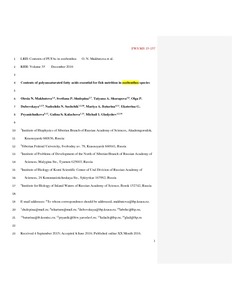Contents of polyunsaturated fatty acids essential for fish nutrition in zoobenthos species
Скачать файл:
DOI:
10.1086/688760URI (для ссылок/цитирований):
http://www.journals.uchicago.edu/doi/abs/10.1086/688760https://elib.sfu-kras.ru/handle/2311/70200
Автор:
Махутова, О. Н.
Шулепина, С. П.
Шарапова, Т. А.
Дубовская, О. П.
Сущик, Н. Н.
Батурина, М. А.
Пряничникова, Е. Г.
Калачева, Г. С.
Гладышев, М. И.
Коллективный автор:
Институт фундаментальной биологии и биотехнологии
Кафедра водных и наземных экосистем
Дата:
2016-12Журнал:
Freshwater ScienceКвартиль журнала в Scopus:
Q1Квартиль журнала в Web of Science:
Q2Библиографическое описание:
Махутова, О. Н. Contents of polyunsaturated fatty acids essential for fish nutrition in zoobenthos species [Текст] / О. Н. Махутова, С. П. Шулепина, Т. А. Шарапова, О. П. Дубовская, Н. Н. Сущик, М. А. Батурина, Е. Г. Пряничникова, Г. С. Калачева, М. И. Гладышев // Freshwater Science. — 2016. — Т. 35 (№ 4). — С. 1222-1234Текст статьи не публикуется в открытом доступе в соответствии с политикой журнала.
Аннотация:
Content of eicosapentaenoic acid (EPA, 20:5n-3) and docosahexaenoic acid (DHA, 24 22:6n-3) and the n-3/n-6 ratio are important indicators of nutritive value of aquatic invertebrates 25 as food for fish. We studied fatty acid (FA) content and composition of 68 zoobenthic species. 26 Benthic invertebrates differed significantly in their contents of EPA and DHA and n-3/n-6 ratios. 27 The most valuable food for fish were Insecta, especially Ephemeroptera and Trichoptera, 28 Gammaridae, and Turbellaria (Dendrocaelopsis sp.). The invertebrates of low food quality for 29 fish were Hirudinea, Mollusca, Oligochaeta, Bryozoa (Plumatella emarginata), and Coleoptera 30 (Dytiscus lapponicus). Our data suggest that the recent and ongoing global replacement of native 31 species, mainly Insecta, by invaders, mostly represented by Mollusca, Crustacea, Polychaeta, 32 Oligochaeta, Bryozoa, and Hirudinea, probably will reduce the nutritive value of food sources 33 for benthivorous fish. In addition, some of the taxa studied have peculiar FAs, which may be 34 useful as their markers in trophic webs. Thus, 20:1n-13, 20:2n-6, 22:5n-3, and 22:6n-3 are likely 35 to be considered markers of Mollusca, Hirudinea, Turbellaria, and Gammaridae, respectively, for 36 tracing food webs in freshwater ecosystems.

